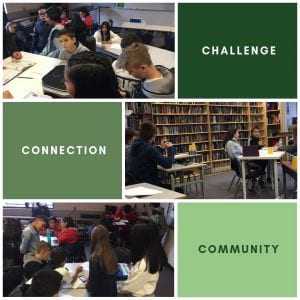The goal of pretty much any teacher is to encourage learning in her students, though teachers may disagree about what type of learning and how it should be encouraged in their students. Personally, I believe that no learning can occur without an environment of community and connection. I’m not saying that everyone needs to be best friends with everyone else, but I strongly believe that we can’t learn unless we feel safe, unless we feel like we can take risks and be wrong without someone judging or making fun of us.
This is why I spend so much time at the beginning of the year trying to build a sense of understanding and respect between us all – and I include myself in this. I am a part of the learning community of our classroom as much as my students. I was reading a book by Dr. Brene Brown called Daring Greatly, and she talks about how when people are at a distance, it’s easy to judge them or stereotype them, but when we come closer, when we get to know people, that prejudice falls away. Once we get to know people, once we try to understand them, we are much less likely to bully or hurt them. It’s not that we necessarily want to be great friends with them, but we can understand why they do the things we do and have more patience.
Most of the time, I feel like I do a pretty good job creating a sense of community in the classroom – helping students feel safe enough to take the risk of being wrong when they share ideas, opening up space where students will reach out to help each other rather than sit back and watch them struggle, making it possible for students to guide their own learning without a fear of failure, etc. Sometimes, though, something happens in the class that makes me wonder if the sense of community that I have been seeing actually wasn’t that. I wonder if the part of the class that I don’t see or hear includes the safety that I so want for my students.
Honestly, I don’t know that there is any way for me to find this out for certain. All I can do is ask my students: Do you feel safe enough in this classroom (with me? with your peers?) to be willing to take risks and try new things?
In short, is our environment a learning community, or a classroom?


